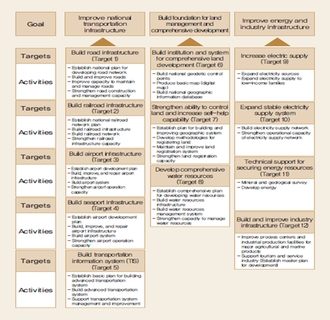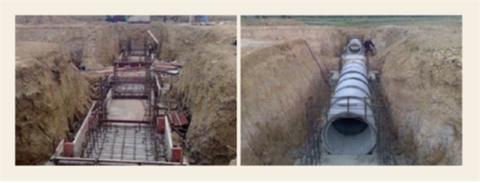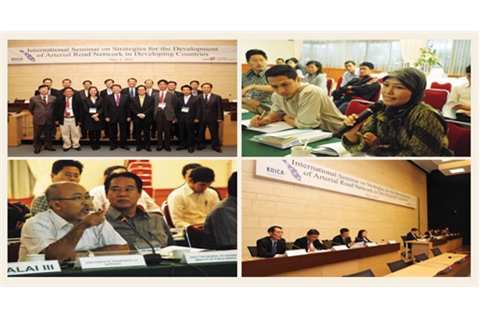official aid
Aid for industry and energy
Industry and Energy
1. Overview
Industry and energy is a central element in economic development and has contributed significantly to national growth. Therefore, the majority of developing countries assign industry and energy as central targets of aid to establish a foundation for the development of their economies.
The lack of basic infrastructure such as roads, railways and airports of developing countries increases the cost of goods. Compounding this are obstructions in economic productivity, including the lack of development in water resources and energy. These obstacles impede poverty eradication. Therefore, developing countries need to build basic infrastructure, water resource and energy facilities. However, these countries still lack finances, facilities and skills.
At the MDG summit in 2000 and the MDG+5 Summit in 2005, the UN emphasized the importance of industry and energy sector development aid. This includes support for the construction of infrastructure in developing countries. Furthermore, in order to eradicate poverty, the OECD/DAC, in the Guiding Principle on Using Infrastructure to Reduce Poverty, stressed the importance of industry and energy aid in eradicating poverty.
2. Performance
KOICA provides engineering aid in energy development, supply in the form of basic infrastructure construction (including transport, water resources and regional management) and electrical energy to support industry and energy sector development.
From 1991 to 2001, KOICA participated in over 150 efforts that provided a total of USD 200.57 million in industry and energy sector development. The amount of aid in the industry and energy sector has steadily increased after the inception on KOICA. In 1991 the amount of aid in this sector was USD 400,000. In 2004 it grew to over USD 10 million. Currently aid in this sector stands at USD 20 million to $30 million.
Since 2006, KOICA has modified the way in which it provides industry and energy sector aid, concentrating on project implementation through technical assistance in the form of consulting and development research. As a result, while the number of construction projects decreased from 9 and 11 in 2006 and 2007 respectively, to 9 and 5 in 2008 and 2009 respectively, the number of development research projects supported remained consistent at 10 and 11 in 2008 and 2009 respectively.
In 1991, the size of KOICA’s entire budget dedicated to the industry and energy sector grew from 0.07% to 2-5%. Since 2005, after being included as one of KOICA’s main seven sectors of aid, the size of industry and energy sector aid has gradually increased.
Meanwhile, the size of the industry and energy sector aid projects that KOICA participates in, such as the construction of roads, bridges, dams, power stations and airports has become too large for KOICA to manage alone. Therefore, KOICA is attempting to work in collaboration with the Korea Exim bank.
Source: Korea International Cooperation Agency. 2011. 20 years of KOICA 1991-2010, Translated by Institute for Development and Human Security, Ewha Womans University. Seoul.
3. Strategy and Institutional Improvement
The goal of KOICA’s industry and energy sector projects is to contribute to the economic development of cooperating countries and the achievement of MDGs. Furthermore, the revitalization of markets within developing countries through this aid will act as the base for the expansion of Korean firms. This will contribute to the strengthening of economic cooperation between Korea and cooperating countries. Emphasized implementation strategies will be initiated first. National transport infrastructure improvement (roads, railway, airports, ports, bridges and other infrastructure) and regional management of basic infrastructure will follow. Lastly, energy infrastructure improvement and other related aid will be implemented.
During the initial stages of project development, the developmental stage and geographical characteristics of the cooperating country is considered. This determines the comparative advantage of the specific country, customizing aid projects towards this strength. Program-form project methods are also implemented in order to maximize project effectiveness. To maximize capacity building and ownership of cooperating countries, aid in the form of invited training and dispatching specialists continuously occurs.
Since 2006, KOICA has operated a specialist pool system to effectively utilize human resources. By systematically managing the specialists in the industry and energy sector, KOICA promoted its participation in the field.
Furthermore, KOICA actively supported the participation of Korean firms in projects through the realization of tender qualifications and the revision of skill evaluation standards. The government policies intending to grow small and medium sized businesses were especially considered. To accomplish this, necessary standards were revised and institutions reformed to facilitate the participation of Korea firms.
After 2010, with the aim of more effectively providing aid in the industry and energy sector, KOICA maximized the effects of program based and continuous aid by synchronizing the goals of implementation and methods of aid.
[Figure 3-1] The Industry and Energy Sector Strategy

The foundation of Korea’s economic growth in the last half-century was the development of industry and energy. Therefore, it is KOICA’s intention to utilize the experience of Korean firms that took part in this development by promoting their participation in developing country ODA projects. To achieve this, KOICA will promote the expansion of industry energy sector aid, formulate methods to effectively transfer Korea’s experience in development in this sector, work together with local business within developing countries and enhance development cooperation through participation in foreign aid markets.
4. Best Practices
A. Batey Flood Control Project and Irrigation Canal Construction Project in Cambodia
In August 2008, the meteorological survey in Cambodia requested construction of a 32 km irrigation canal on the outside of a newly built embankment in Batey. It also requested building 23 culverts and flood regulating gates to provide irrigation to 4,000ha of farmlands. This would address the serious imbalance of water resources in the region and increase agricultural productivity.
The project took place in 20 villages made up of 5,650 households, which in total consisted of 30,550 individuals. It included construction of irrigation systems to support three-crop farming, which increased agricultural productivity. The project also had the goal to increase the income of residents, reducing poverty in the areas.
This project is credited with installing canals that supply irrigation to 4,000ha of farmland (including 1,600ha of newly formed farmland) and building culverts and flood regulating gates. The efforts successfully transferred skills to Cambodian employees through measurement and soil surveying, basic and final designs, construction supervision and operational management.
Additionally, with effective follow-up maintenance and skill transfer measures, government employees and a majority of residents residing in the project areas joined the Farmer Water User Committee (FWUC). In cooperation with the water-resources and meteorological survey, an irrigation system training program was developed during the first half of 2009. From August to November 2009, local farm workers (5,650 households in total), FWUC officials and government employees underwent training for operating and maintaining irrigation systems. This training contributed to more effective maintenance and operation. Assessments also show it is an appropriate and practical training program for local conditions.
As a result of the flood control project in the Batey region, embankments were built, which established more land with running water and simplified the irrigation canals and flood control measures. Furthermore, the irrigation canal construction project in this region satisfied the need for more effective irrigation to widely spread out farmlands. The step by step implementation of projects and their ability to complement each other contributed to the region’s sustainable development.
[Figure 4-1] Construction process of Batey irrigation system

B. Sumatra, Indonesia Highway Network Master Plan Establishment Project
This project formed a complex highway network master plan in the Sumatra region of Indonesia. It aimed to contribute to the economic growth of the region. The plan proposed measures for structural improvements and disaster management. These included development of national road and drainage systems and construction plans for a highway network and city bypass to improve transport speeds. The goal of this plan is to make the Sumatra region into a one day transport life zone by 2029.
The dispatch of transport, road, environmental and regional specialists is currently underway to conduct status surveys and collect the opinions of relevant institutions before the project can begins. To reinforce the competency of road related specialists, training within Korea has also commenced. Additionally, the requests of the Indonesian government have been actively implemented and a symposium on the construction plans of toll roads has been opened. A lecture on implementation measures for 2+1 crossroads, manual writing and training, and the production of toll road and highway project publicity pamphlets were additionally conducted.
In May 2010, an international seminar entitled “Development Plans for Highway Networks in Developing Countries”was held to increase the effectiveness of the project. The seminar determined methods to realizably and effectively increase financing (including private investment) for aid policies that seek to expand highways. Furthermore, it provided an opportunity for businesses interested in regional penetration to transfer skills. The seminar also served as a forum for interchange between government employees and related personnel.
In July 2010, the final Master Plan report was completed. In August, a briefing session was opened in Indonesia finalizing the project. Follow up projects are under review with the Indonesian government.
[Figure 4-2] Workshop for establishing master plan for building main road network in Sumatra

Source: Korea International Cooperation Agency. 2011. 20 years of KOICA 1991-2010, Translated by Institute for Development and Human Security, Ewha Womans University. Seoul.
